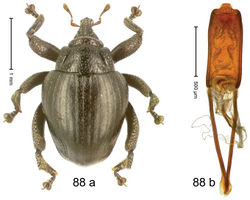Trigonopterus talpa
| Notice: | This page is derived from the original publication listed below, whose author(s) should always be credited. Further contributors may edit and improve the content of this page and, consequently, need to be credited as well (see page history). Any assessment of factual correctness requires a careful review of the original article as well as of subsequent contributions.
If you are uncertain whether your planned contribution is correct or not, we suggest that you use the associated discussion page instead of editing the page directly. This page should be cited as follows (rationale):
Citation formats to copy and paste
BibTeX: @article{Riedel2013ZooKeys280, RIS/ Endnote: TY - JOUR Wikipedia/ Citizendium: <ref name="Riedel2013ZooKeys280">{{Citation See also the citation download page at the journal. |
Ordo: Coleoptera
Familia: Curculionidae
Genus: Trigonopterus
Name
Trigonopterus talpa Riedel sp. n. – Wikispecies link – ZooBank link – Pensoft Profile
Diagnostic description
Holotype, male (Fig. 88a). Length 2.63 mm. Color black; legs dark ferruginous; antenna light ferruginous. Body subrhomboid; with marked constriction between pronotum and elytron; in profile evenly convex to subapical constriction of pronotum. Rostrum with pair of sublateral furrows converging posteriorly on forehead; pair of submedian furrows shallow; epistome forming angulate ridge and median denticle. Pronotum with marked subapical constriction, sides weakly converging, behind subapical constriction with angular protrusions; disk with pair of deep furrows curving anteriad joining subapical constriction; center of disk coriaceous, sparsely punctate; laterally rugose. Elytra subovate, apically subangulate; striae weakly impressed; surface dull, microgranulate, almost nude, with sparse minute setae; interval 7 subapically forming distinct, weakly denticulate ridge; apex extended ventrad, slightly beak-shaped in profile. Femora edentate. Meso- and metatibia in basal half widened, subapically narrowed. Metafemur with denticulate dorsoposterior edge, subapically without stridulatory patch. Aedeagus (Fig. 88b) with body parallel-sided; apex medially extended into subtruncate tip; transfer apparatus thick spiniform; ductus ejaculatorius without bulbus. Intraspecific variation. Length 2.30–2.63 mm. Female rostrum in apical half medially subglabrous, with two rows of punctures; epistome simple.
Material examined
Holotype (MZB): ARC1686 (EMBL # HE615973), WEST NEW GUINEA, Jayapura Reg., Cyclops Mts, Angkasa indah, S02°30.346', E140°42.087', 490 m, 28-VI-2010, sifted. Paratype (SMNK): 1 ex, ARC1687 (EMBL # HE615974), same data as holotype.
Distribution
Jayapura Reg. (Cyclops Mts). Elevation: 490 m.
Biology
Sifted from leaf litter in primary forest.
Etymology
This epithet is based on the Latin noun talpa (mole) in apposition and refers both to the species´ habitus and its edaphic habits.
Notes
Trigonopterus talpa Riedel, sp. n. was coded as “Trigonopterus sp. 77” by Tänzler et al. (2012)[1].
Original Description
- Riedel, A; Sagata, K; Surbakti, S; Rene Tänzler, ; Michael Balke, ; 2013: One hundred and one new species of Trigonopterus weevils from New Guinea ZooKeys, 280: 1-150. doi
Other References
- ↑ Tänzler R, Sagata K, Surbakti S, Balke M, Riedel A (2012) DNA barcoding for community ecology - how to tackle a hyperdiverse, mostly undescribed Melanesian fauna. PLoS ONE 7 (1): e28832. doi: 10.1371/journal.pone.0028832
Images
|
